Over the course of time, there is a different welding technique that has been used which is designed to promote more significant benefits in the industry. There is an abrupt increase in technical development throughout the aspect of field operations today. This is a result of an abrupt climb in technology, innovation, and labor force. The laser welding also endures the same limitations regarding plastic welding methods. But as these tools, techniques, and equipment have further developed, average individuals have not yet obtained enough information about the important and intricate procedure of welding techniques. In this manner, knowing how plastic laser welding works is important in the industry.
Ideally, this is also called as the through transmission welding. But what is it all about? It is generally a procedure that is done by experts that would allow plastics to bind with the helpful use of laser radiation. This process is highly different from what you know about the traditional process with the use of metal. The concept runs through different steps which may also include complex to basic procedures.
This would usually include transporting a laser beam that goes through a laser transmissive portion down to an interface that allows two parts to join together. The joining partner for the lower part would be the one that would absorb the heat energy that is transformed from laser light. By then, a process of heating is done which typically makes a molten weld. More so, two plastics will be fused too.
Ideally, the procedure is dependent on different aspects. This includes the absorbing layer, transmissive layer, good contact if the different parts, and the compatibility of a material. For the transmissive layer, thermoplastics would be transmitted through laser radiation. Whereas the absorbing layer, it is the aspect where light energy is effectively turned into heat. There are different classifications of additives that would be beneficial for the absorption of qualities to a part. Usually, experts would use carbon black.
Now, the compatibility of materials will be identified through different factors such as polymer chain and the surface energy. However, what is more important for every professional is to make sure that they find the right plastics that obtain the same melting temperature. In fact, there are different application studies regarding polymers. More of these experimentations have considered being effective and successful. But without the materials, techniques, and equipment, it would not achieve to provide different benefits.
In every plastic welding procedure, it would ideally rely on three different parameters which are the time, temperature and pressure. Energy density for the process is important in combining the time and temperature parameters. A low energy density would always result in a lack of heating which may result in a long time until it forms a stronger weld. But a higher density may cause degradation of the polymer.
People have a common misconception when it comes to the requirement of laser welding plastics. Most of them would think that it is needed to have an opaque part and a clear part. But you are highly mistaken since you can weld clear to clear. Other than that, it is also allowable to weld with an opaque to opaque requirement. Other than that, increasing wavelength lasers go through the diverse procedure with the through transmission.
Generally, the processes of laser welding of plastics are reliable when it comes to safety, accuracy, and cleanliness as compared with the traditional method. It is highly relevant in the medical, sensor, automotive and electronics industry. There are many manufacturing companies that you can rely on with purchasing the machines. Indeed, the manufacturing company has been competitive today.

So what could you expect in the future of the industry? The pulse of the community has projected an optimistic future. To get a firm pulse, assess the current state regarding the research and design providers, equipment, accessories, consumables, and welded products. The majority of the community believes that it will be more useful for future endeavors. This is because of the increasing demand for cost effectiveness in methods for joining metals and plastics altogether.
